多方式进化遗传算法Matlab源代码
- 格式:doc
- 大小:62.50 KB
- 文档页数:9
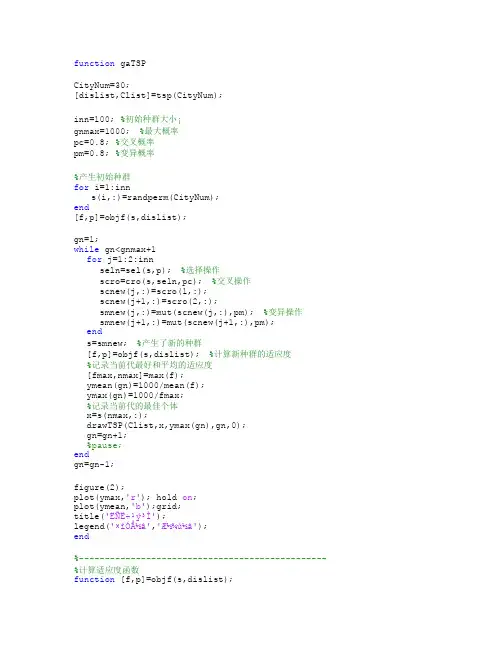
function gaTSPCityNum=30;[dislist,Clist]=tsp(CityNum);inn=100; %初始种群大小¡gnmax=1000; %最大概率pc=0.8; %交叉概率pm=0.8; %变异概率%产生初始种群for i=1:inns(i,:)=randperm(CityNum);end[f,p]=objf(s,dislist);gn=1;while gn<gnmax+1for j=1:2:innseln=sel(s,p); %选择操作scro=cro(s,seln,pc); %交叉操作scnew(j,:)=scro(1,:);scnew(j+1,:)=scro(2,:);smnew(j,:)=mut(scnew(j,:),pm); %变异操作smnew(j+1,:)=mut(scnew(j+1,:),pm);ends=smnew; %产生了新的种群[f,p]=objf(s,dislist); %计算新种群的适应度%记录当前代最好和平均的适应度[fmax,nmax]=max(f);ymean(gn)=1000/mean(f);ymax(gn)=1000/fmax;%记录当前代的最佳个体x=s(nmax,:);drawTSP(Clist,x,ymax(gn),gn,0);gn=gn+1;%pause;endgn=gn-1;figure(2);plot(ymax,'r'); hold on;plot(ymean,'b');grid;title('ËÑË÷¹ý³Ì');legend('×îÓŽâ','ƽ¾ù½â');end%------------------------------------------------%计算适应度函数function [f,p]=objf(s,dislist);inn=size(s,1); %读取种群大小¡for i=1:innf(i)=CalDist(dislist,s(i,:)); %计算函数值,即适应度endf=1000./f';%计算选择概率fsum=0;for i=1:innfsum=fsum+f(i)^15;endfor i=1:innps(i)=f(i)^15/fsum;end%计算累积概率p(1)=ps(1);for i=2:innp(i)=p(i-1)+ps(i);endp=p';end%--------------------------------------------------function pcc=pro(pc);test(1:100)=0;l=round(100*pc);test(1:l)=1;n=round(rand*99)+1;pcc=test(n);end%--------------------------------------------------%“选择”操作function seln=sel(s,p);inn=size(p,1);%从种群中选择两个个体for i=1:2r=rand; %产生一个随机数prand=p-r;j=1;while prand(j)<0j=j+1;endseln(i)=j; %选中个体的序号endend%------------------------------------------------%“交叉”操作function scro=cro(s,seln,pc);bn=size(s,2);pcc=pro(pc); %根据交叉概率决定是否进行交叉操作,1则是,0则否scro(1,:)=s(seln(1),:);scro(2,:)=s(seln(2),:);if pcc==1c1=round(rand*(bn-2))+1; %在[1,bn-1]范围内随机产生一个交叉位 c2=round(rand*(bn-2))+1;chb1=min(c1,c2);chb2=max(c1,c2);middle=scro(1,chb1+1:chb2);scro(1,chb1+1:chb2)=scro(2,chb1+1:chb2);scro(2,chb1+1:chb2)=middle;for i=1:chb1while find(scro(1,chb1+1:chb2)==scro(1,i))zhi=find(scro(1,chb1+1:chb2)==scro(1,i));y=scro(2,chb1+zhi);scro(1,i)=y;endwhile find(scro(2,chb1+1:chb2)==scro(2,i))zhi=find(scro(2,chb1+1:chb2)==scro(2,i));y=scro(1,chb1+zhi);scro(2,i)=y;endendfor i=chb2+1:bnwhile find(scro(1,1:chb2)==scro(1,i))zhi=find(scro(1,1:chb2)==scro(1,i));y=scro(2,zhi);scro(1,i)=y;endwhile find(scro(2,1:chb2)==scro(2,i))zhi=find(scro(2,1:chb2)==scro(2,i));y=scro(1,zhi);scro(2,i)=y;endendendend%--------------------------------------------------%“变异”操作function snnew=mut(snew,pm);bn=size(snew,2);snnew=snew;pmm=pro(pm); %¸根据变异概率决定是否进行变异操作,1则是,0则否if pmm==1c1=round(rand*(bn-2))+1; %在[1,bn-1]范围内随机产生一个变异位 c2=round(rand*(bn-2))+1;chb1=min(c1,c2);chb2=max(c1,c2);x=snew(chb1+1:chb2);snnew(chb1+1:chb2)=fliplr(x); endend。
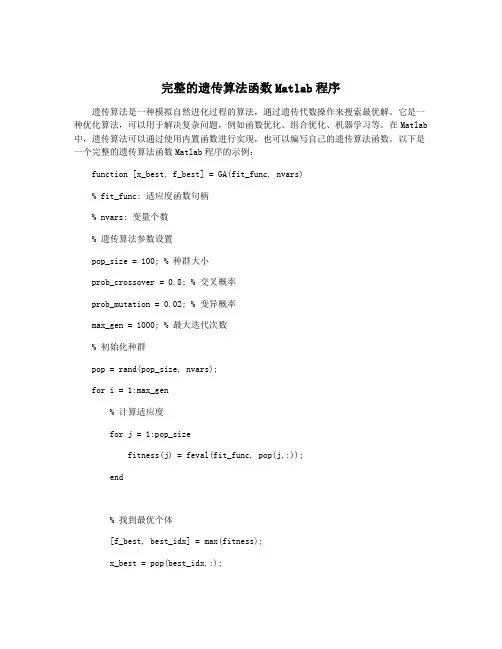
完整的遗传算法函数Matlab程序遗传算法是一种模拟自然进化过程的算法,通过遗传代数操作来搜索最优解。
它是一种优化算法,可以用于解决复杂问题,例如函数优化、组合优化、机器学习等。
在Matlab 中,遗传算法可以通过使用内置函数进行实现,也可以编写自己的遗传算法函数。
以下是一个完整的遗传算法函数Matlab程序的示例:function [x_best, f_best] = GA(fit_func, nvars)% fit_func: 适应度函数句柄% nvars: 变量个数% 遗传算法参数设置pop_size = 100; % 种群大小prob_crossover = 0.8; % 交叉概率prob_mutation = 0.02; % 变异概率max_gen = 1000; % 最大迭代次数% 初始化种群pop = rand(pop_size, nvars);for i = 1:max_gen% 计算适应度for j = 1:pop_sizefitness(j) = feval(fit_func, pop(j,:));end% 找到最优个体[f_best, best_idx] = max(fitness);x_best = pop(best_idx,:);% 交叉操作for j = 1:2:pop_sizeif rand < prob_crossover% 随机选择父代idx_parent1 = randi(pop_size);idx_parent2 = randi(pop_size);parent1 = pop(idx_parent1,:);parent2 = pop(idx_parent2,:);% 交叉idx_crossover = randi(nvars-1);child1 = [parent1(1:idx_crossover) parent2(idx_crossover+1:end)];child2 = [parent2(1:idx_crossover) parent1(idx_crossover+1:end)];% 更新种群pop(j,:) = child1;pop(j+1,:) = child2;endend% 变异操作for j = 1:pop_sizeif rand < prob_mutation% 随机选择变异个体idx_mutation = randi(nvars);pop(j,idx_mutation) = rand;endendendend在上述程序中,遗传算法的参数通过设定变量的值进行设置,包括种群大小、交叉概率、变异概率和最大迭代次数等。
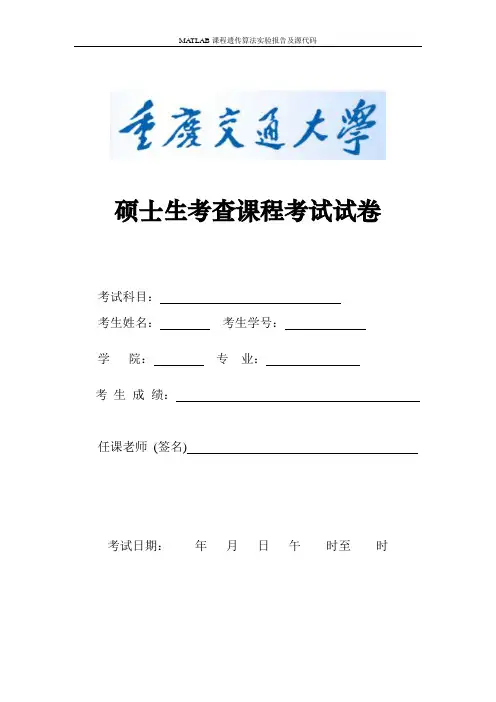
硕士生考查课程考试试卷考试科目:考生姓名:考生学号:学院:专业:考生成绩:任课老师(签名)考试日期:年月日午时至时《MATLAB 教程》试题:A 、利用MATLAB 设计遗传算法程序,寻找下图11个端点最短路径,其中没有连接端点表示没有路径。
要求设计遗传算法对该问题求解。
ae h kB 、设计遗传算法求解f (x)极小值,具体表达式如下:321231(,,)5.12 5.12,1,2,3i i i f x x x x x i =⎧=⎪⎨⎪-≤≤=⎩∑ 要求必须使用m 函数方式设计程序。
C 、利用MATLAB 编程实现:三名商人各带一个随从乘船渡河,一只小船只能容纳二人,由他们自己划行,随从们密约,在河的任一岸,一旦随从的人数比商人多,就杀人越货,但是如何乘船渡河的大权掌握在商人手中,商人们怎样才能安全渡河?D 、结合自己的研究方向选择合适的问题,利用MATLAB 进行实验。
以上四题任选一题进行实验,并写出实验报告。
选择题目:B 、设计遗传算法求解f (x)极小值,具体表达式如下:321231(,,)5.12 5.12,1,2,3i i i f x x x x x i =⎧=⎪⎨⎪-≤≤=⎩∑ 要求必须使用m 函数方式设计程序。
一、问题分析(10分)这是一个简单的三元函数求最小值的函数优化问题,可以利用遗传算法来指导性搜索最小值。
实验要求必须以matlab 为工具,利用遗传算法对问题进行求解。
在本实验中,要求我们用M 函数自行设计遗传算法,通过遗传算法基本原理,选择、交叉、变异等操作进行指导性邻域搜索,得到最优解。
二、实验原理与数学模型(20分)(1)试验原理:用遗传算法求解函数优化问题,遗传算法是模拟生物在自然环境下的遗传和进化过程而形成的一种自适应全局优化概率搜索方法。
其采纳了自然进化模型,从代表问题可能潜在解集的一个种群开始,种群由经过基因编码的一定数目的个体组成。
每个个体实际上是染色体带有特征的实体;初始种群产生后,按照适者生存和优胜劣汰的原理,逐代演化产生出越来越好的解:在每一代,概据问题域中个体的适应度大小挑选个体;并借助遗传算子进行组合交叉和主客观变异,产生出代表新的解集的种群。
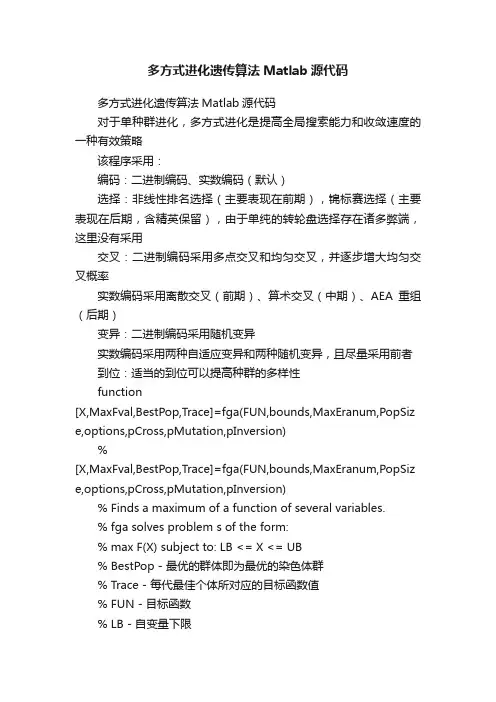
多方式进化遗传算法Matlab源代码多方式进化遗传算法Matlab源代码对于单种群进化,多方式进化是提高全局搜索能力和收敛速度的一种有效策略该程序采用:编码:二进制编码、实数编码(默认)选择:非线性排名选择(主要表现在前期),锦标赛选择(主要表现在后期,含精英保留),由于单纯的转轮盘选择存在诸多弊端,这里没有采用交叉:二进制编码采用多点交叉和均匀交叉,并逐步增大均匀交叉概率实数编码采用离散交叉(前期)、算术交叉(中期)、AEA重组(后期)变异:二进制编码采用随机变异实数编码采用两种自适应变异和两种随机变异,且尽量采用前者到位:适当的到位可以提高种群的多样性function[X,MaxFval,BestPop,Trace]=fga(FUN,bounds,MaxEranum,PopSiz e,options,pCross,pMutation,pInversion)%[X,MaxFval,BestPop,Trace]=fga(FUN,bounds,MaxEranum,PopSiz e,options,pCross,pMutation,pInversion)% Finds a maximum of a function of several variables.% fga solves problem s of the form:% max F(X) subject to: LB <= X <= UB% BestPop - 最优的群体即为最优的染色体群% Trace - 每代最佳个体所对应的目标函数值% FUN - 目标函数% LB - 自变量下限% UB - 自变量上限% eranum - 种群的代数,取50--500(默认200)% popsize - 每一代种群的规模;此可取50--200(默认100)% pcross - 交叉概率,一般取0.5--0.85之间较好(默认0.8)% pmutation - 初始变异概率,一般取0.05-0.2之间较好(默认0.1) % pInversion - 倒位概率,一般取0.05-0.3之间较好(默认0.2) % options - 1*2矩阵,options(1)=0二进制编码(默认0),option(1)~=0十进制编码,option(2)设定求解精度(默认1e-4)T1=clock;%检验初始参数if nargin<2, error('FMAXGA requires at least three input arguments'); endif nargin==2, MaxEranum=100;PopSize=100;options=[1 1e-4];pCross=0.85;pMutation=0.1;pInversion=0.25;endif nargin==3, PopSize=100;options=[1 1e-4];pCross=0.85;pMutation=0.1;pInversion=0.25;endif nargin==4, options=[1 1e-4];pCross=0.85;pMutation=0.1;pInversion=0.25;endif nargin==5, pCross=0.85;pMutation=0.1;pInversion=0.25;endif nargin==6, pMutation=0.1;pInversion=0.25;endif nargin==7, pInversion=0.25;endif (options(1)==0|options(1)==1)&find((bounds(:,1)-bounds(:,2))>0)error('数据输入错误,请重新输入:');end%s=sprintf('程序运行需要约%.4f 秒钟时间,请稍等......',(eranum*popsize/1000));%disp(s);% 定义全局变量global m n NewPop children1 children2 VarNum% 初始化种群和变量precision = options(2);bits = ceil(log2((bounds(:,2)-bounds(:,1))' ./ precision));%由设定精度划分区间VarNum = size(bounds,1);[Pop] = InitPop(PopSize,bounds,bits,options);%初始化种群[m,n] = size(Pop);fit = zeros(1,m);NewPop = zeros(m,n);children1 = zeros(1,n);children2 = zeros(1,n);pm0 = pMutation;BestPop = zeros(MaxEranum,n);%分配初始解空间BestPop,TraceTrace = zeros(1,MaxEranum);Lb = ones(PopSize,1)*bounds(:,1)';Ub = ones(PopSize,1)*bounds(:,2)';%二进制编码采用多点交叉和均匀交叉,并逐步增大均匀交叉概率%浮点编码采用离散交叉(前期)、算术交叉(中期)、AEA重组(后期)OptsCrossOver = [ones(1,MaxEranum)*options(1);...round(unidrnd(2*(MaxEranum-[1:MaxEranum]))/MaxEranum)]';%浮点编码时采用两种自适应变异和一种随机变异(自适应变异发生概率为随机变异发生的2倍)OptsMutation = [ones(1,MaxEranum)*options(1);unidrnd(5,1,MaxEranum)]';if options(1)==3D=zeros(n);CityPosition=bounds;D = sqrt((CityPosition(:, ones(1,n)) - CityPosition(:, ones(1,n))').^2 +...(CityPosition(:,2*ones(1,n)) - CityPosition(:,2*ones(1,n))').^2 );end%===================================== ==================================== % 进化主程序 %%===================================== ==================================== eranum = 1;while(eranum<=MaxEranum)for j=1:mif options(1)==1%eval(['[fit(j)]=' FUN '(Pop(j,:));']);%但执行字符串速度比直接计算函数值慢fit(j)=feval(FUN,Pop(j,:));%计算适应度elseif options(1)==0%eval(['[fit(j)]=' FUN '(b2f(Pop(j,:),bounds,bits));']);fit(j)=feval(FUN,(b2f(Pop(j,:),bounds,bits)));elsefit(j)=-feval(FUN,Pop(j,:),D);endend[Maxfit,fitIn]=max(fit);%得到每一代最大适应值BestPop(eranum,:)=Pop(fitIn,:);Trace(eranum)=Maxfit;if options(1)==1Pop=(Pop-Lb)./(Ub-Lb);%将定义域映射到[0,1]:[Lb,Ub]-->[0,1] ,Pop-->(Pop-Lb)./(Ub-Lb)endswitch round(unifrnd(0,eranum/MaxEranum))%进化前期尽量使用实行锦标赛选择,后期逐步增大非线性排名选择 case {0} [selectpop]=T ournam entSelect(Pop,fit,bits);%锦标赛选择case {1}[selectpop]=NonlinearRankSelect(Pop,fit,bits);%非线性排名选择end[CrossOverPop]=CrossOver(selectpop,pCross,OptsCrossOve r(eranum,:));%交叉[MutationPop]=Mutation(CrossOverPop,fit,pMutation,VarN um,OptsMutation(eranum,:)); %变异%[MutationPop]=Mutation(selectpop,fit,pMutation,VarNum ,OptsMutation(eranum,:)); %变异[InversionPop]=Inversion(MutationPop,pInversion);%倒位%更新种群if options(1)==1Pop=Lb+InversionPop.*(Ub-Lb);%还原PopelsePop=InversionPop;endpMutation=pm0+(eranum^3)*(pCross/2-pm0)/(eranum^4); %逐步增大变异率至1/2交叉率eranum=eranum+1;end% 格式化输出进化结果和解的变化情况t=1:MaxEranum;plot(t,Trace);title('函数优化的遗传算法');xlabel('进化世代数');ylabel('每一代最优适应度');[MaxFval,MaxFvalIn]=max(Trace);if options(1)==1|options(1)==3X=BestPop(MaxFvalIn,:);elseif options(1)==0X=b2f(BestPop(MaxFvalIn,:),bounds,bits);endX,MaxFvalhold on;plot(MaxFvalIn,MaxFval,'*');text(MaxFvalIn+5,MaxFval,['FMAX=' num2str(MaxFval)]);str1=sprintf('进化到%d 代,自变量为%s 时,得最优值%f\n对应个体是:%s',...MaxFvalIn,num2str(X),MaxFval,num2str(BestPop(MaxFvalIn,: )));disp(str1);% -计时T2=clock;elapsed_time=T2-T1;if elapsed_time(6)<0elapsed_time(6)=elapsed_time(6)+60;elapsed_time(5)=elapsed_time(5)-1;endif elapsed_time(5)<0elapsed_time(5)=elapsed_time(5)+60;elapsed_time(4)=elaps ed_time(4)-1;endstr2=sprintf('程序运行耗时%d 小时%d 分钟%.4f 秒',elapsed_time(4),elapsed_time(5),elapsed_time(6));disp(str2);%===================================== ==================================== = % 遗传操作子程序%%===================================== ==================================== = % -- 初始化种群--% 采用浮点编码和二进制Gray编码(为了克服二进制编码的Hamming悬崖缺点)function [initpop]=InitPop(popsize,bounds,bits,options)numVars=size(bounds,1);%变量数目rang=(bounds(:,2)-bounds(:,1))';%变量范围if options(1)==1initpop=zeros(popsize,numVars);initpop=(ones(popsize,1)*rang).*(rand(popsize,numVars))+( ones(popsize,1)*bounds(:,1)');elseif options(1)==0precision=options(2);%由求解精度确定二进制编码长度len=sum(bits);initpop=zeros(popsize,len);%The whole zero encoding individualfor i=2:popsize-1pop=round(rand(1,len));pop=mod(([0 pop]+[pop 0]),2);%i=1时,b(1)=a(1);i>1时,b(i)=mod(a(i-1)+a(i),2)%其中原二进制串:a(1)a(2)...a(n),Gray串:b(1)b(2)...b(n)initpop(i,:)=pop(1:end-1);endinitpop(popsize,:)=ones(1,len);%The whole one encoding individualelsefor i=1:popsizeinitpop(i,:)=randperm(numVars);%为Tsp问题初始化种群endend% -- 二进制串解码--function [fval] = b2f(bval,bounds,bits)% fval - 表征各变量的十进制数% bval - 表征各变量的二进制编码串% bounds - 各变量的取值范围% bits - 各变量的二进制编码长度scale=(bounds(:,2)-bounds(:,1))'./(2.^bits-1); %The range of the variablesnumV=size(bounds,1);cs=[0 cumsum(bits)];for i=1:numVa=bval((cs(i)+1):cs(i+1));fval(i)=sum(2.^(size(a,2)-1:-1:0).*a)*scale(i)+bounds(i,1);。
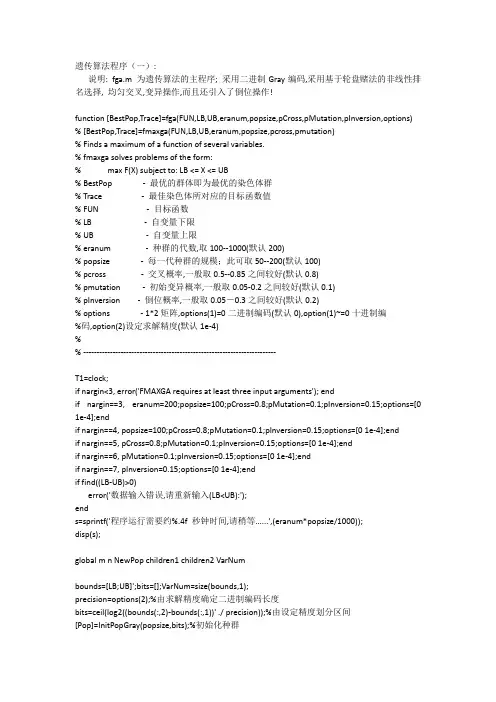
遗传算法程序(一):说明: fga.m 为遗传算法的主程序; 采用二进制Gray编码,采用基于轮盘赌法的非线性排名选择, 均匀交叉,变异操作,而且还引入了倒位操作!function [BestPop,Trace]=fga(FUN,LB,UB,eranum,popsize,pCross,pMutation,pInversion,options) % [BestPop,Trace]=fmaxga(FUN,LB,UB,eranum,popsize,pcross,pmutation)% Finds a maximum of a function of several variables.% fmaxga solves problems of the form:% max F(X) subject to: LB <= X <= UB% BestPop - 最优的群体即为最优的染色体群% Trace - 最佳染色体所对应的目标函数值% FUN - 目标函数% LB - 自变量下限% UB - 自变量上限% eranum - 种群的代数,取100--1000(默认200)% popsize - 每一代种群的规模;此可取50--200(默认100)% pcross - 交叉概率,一般取0.5--0.85之间较好(默认0.8)% pmutation - 初始变异概率,一般取0.05-0.2之间较好(默认0.1)% pInversion - 倒位概率,一般取0.05-0.3之间较好(默认0.2)% options - 1*2矩阵,options(1)=0二进制编码(默认0),option(1)~=0十进制编%码,option(2)设定求解精度(默认1e-4)%% ------------------------------------------------------------------------T1=clock;if nargin<3, error('FMAXGA requires at least three input arguments'); endif nargin==3, eranum=200;popsize=100;pCross=0.8;pMutation=0.1;pInversion=0.15;options=[0 1e-4];endif nargin==4, popsize=100;pCross=0.8;pMutation=0.1;pInversion=0.15;options=[0 1e-4];endif nargin==5, pCross=0.8;pMutation=0.1;pInversion=0.15;options=[0 1e-4];endif nargin==6, pMutation=0.1;pInversion=0.15;options=[0 1e-4];endif nargin==7, pInversion=0.15;options=[0 1e-4];endif find((LB-UB)>0)error('数据输入错误,请重新输入(LB<UB):');ends=sprintf('程序运行需要约%.4f 秒钟时间,请稍等......',(eranum*popsize/1000));disp(s);global m n NewPop children1 children2 VarNumbounds=[LB;UB]';bits=[];VarNum=size(bounds,1);precision=options(2);%由求解精度确定二进制编码长度bits=ceil(log2((bounds(:,2)-bounds(:,1))' ./ precision));%由设定精度划分区间[Pop]=InitPopGray(popsize,bits);%初始化种群[m,n]=size(Pop);NewPop=zeros(m,n);children1=zeros(1,n);children2=zeros(1,n);pm0=pMutation;BestPop=zeros(eranum,n);%分配初始解空间BestPop,TraceTrace=zeros(eranum,length(bits)+1);i=1;while i<=eranumfor j=1:mvalue(j)=feval(FUN(1,:),(b2f(Pop(j,:),bounds,bits)));%计算适应度end[MaxValue,Index]=max(value);BestPop(i,:)=Pop(Index,:);Trace(i,1)=MaxValue;Trace(i,(2:length(bits)+1))=b2f(BestPop(i,:),bounds,bits);[selectpop]=NonlinearRankSelect(FUN,Pop,bounds,bits);%非线性排名选择[CrossOverPop]=CrossOver(selectpop,pCross,round(unidrnd(eranum-i)/eranum));%采用多点交叉和均匀交叉,且逐步增大均匀交叉的概率%round(unidrnd(eranum-i)/eranum)[MutationPop]=Mutation(CrossOverPop,pMutation,VarNum);%变异[InversionPop]=Inversion(MutationPop,pInversion);%倒位Pop=InversionPop;%更新pMutation=pm0+(i^4)*(pCross/3-pm0)/(eranum^4);%随着种群向前进化,逐步增大变异率至1/2交叉率p(i)=pMutation;i=i+1;endt=1:eranum;plot(t,Trace(:,1)');title('函数优化的遗传算法');xlabel('进化世代数(eranum)');ylabel('每一代最优适应度(maxfitness)');[MaxFval,I]=max(Trace(:,1));X=Trace(I,(2:length(bits)+1));hold on; plot(I,MaxFval,'*');text(I+5,MaxFval,['FMAX=' num2str(MaxFval)]);str1=sprintf ('进化到%d 代,自变量为%s 时,得本次求解的最优值%f\n对应染色体是:%s',I,num2str(X),MaxFval,num2str(BestPop(I,:)));disp(str1);%figure(2);plot(t,p);%绘制变异值增大过程T2=clock;elapsed_time=T2-T1;if elapsed_time(6)<0elapsed_time(6)=elapsed_time(6)+60; elapsed_time(5)=elapsed_time(5)-1;endif elapsed_time(5)<0elapsed_time(5)=elapsed_time(5)+60;elapsed_time(4)=elapsed_time(4)-1;end %像这种程序当然不考虑运行上小时啦str2=sprintf('程序运行耗时%d 小时%d 分钟%.4f 秒',elapsed_time(4),elapsed_time(5),elapsed_time(6));disp(str2);%初始化种群%采用二进制Gray编码,其目的是为了克服二进制编码的Hamming悬崖缺点function [initpop]=InitPopGray(popsize,bits)len=sum(bits);initpop=zeros(popsize,len);%The whole zero encoding individualfor i=2:popsize-1pop=round(rand(1,len));pop=mod(([0 pop]+[pop 0]),2);%i=1时,b(1)=a(1);i>1时,b(i)=mod(a(i-1)+a(i),2)%其中原二进制串:a(1)a(2)...a(n),Gray串:b(1)b(2)...b(n)initpop(i,:)=pop(1:end-1);endinitpop(popsize,:)=ones(1,len);%The whole one encoding individual%解码function [fval] = b2f(bval,bounds,bits)% fval - 表征各变量的十进制数% bval - 表征各变量的二进制编码串% bounds - 各变量的取值范围% bits - 各变量的二进制编码长度scale=(bounds(:,2)-bounds(:,1))'./(2.^bits-1); %The range of the variablesnumV=size(bounds,1);cs=[0 cumsum(bits)];for i=1:numVa=bval((cs(i)+1):cs(i+1));fval(i)=sum(2.^(size(a,2)-1:-1:0).*a)*scale(i)+bounds(i,1);end%选择操作%采用基于轮盘赌法的非线性排名选择%各个体成员按适应值从大到小分配选择概率:%P(i)=(q/1-(1-q)^n)*(1-q)^i, 其中P(0)>P(1)>...>P(n), sum(P(i))=1function [selectpop]=NonlinearRankSelect(FUN,pop,bounds,bits)global m nselectpop=zeros(m,n);fit=zeros(m,1);for i=1:mfit(i)=feval(FUN(1,:),(b2f(pop(i,:),bounds,bits)));%以函数值为适应值做排名依据endselectprob=fit/sum(fit);%计算各个体相对适应度(0,1)q=max(selectprob);%选择最优的概率x=zeros(m,2);x(:,1)=[m:-1:1]';[y x(:,2)]=sort(selectprob);r=q/(1-(1-q)^m);%标准分布基值newfit(x(:,2))=r*(1-q).^(x(:,1)-1);%生成选择概率newfit=cumsum(newfit);%计算各选择概率之和rNums=sort(rand(m,1));fitIn=1;newIn=1;while newIn<=mif rNums(newIn)<newfit(fitIn)selectpop(newIn,:)=pop(fitIn,:);newIn=newIn+1;elsefitIn=fitIn+1;endend%交叉操作function [NewPop]=CrossOver(OldPop,pCross,opts)%OldPop为父代种群,pcross为交叉概率global m n NewPopr=rand(1,m);y1=find(r<pCross);y2=find(r>=pCross);len=length(y1);if len>2&mod(len,2)==1%如果用来进行交叉的染色体的条数为奇数,将其调整为偶数y2(length(y2)+1)=y1(len);y1(len)=[];endif length(y1)>=2for i=0:2:length(y1)-2if opts==0[NewPop(y1(i+1),:),NewPop(y1(i+2),:)]=EqualCrossOver(OldPop(y1(i+1),:),OldPop(y1(i+2),:));else[NewPop(y1(i+1),:),NewPop(y1(i+2),:)]=MultiPointCross(OldPop(y1(i+1),:),OldPop(y1(i+2),:));endendendNewPop(y2,:)=OldPop(y2,:);%采用均匀交叉function [children1,children2]=EqualCrossOver(parent1,parent2)global n children1 children2hidecode=round(rand(1,n));%随机生成掩码crossposition=find(hidecode==1);holdposition=find(hidecode==0);children1(crossposition)=parent1(crossposition);%掩码为1,父1为子1提供基因children1(holdposition)=parent2(holdposition);%掩码为0,父2为子1提供基因children2(crossposition)=parent2(crossposition);%掩码为1,父2为子2提供基因children2(holdposition)=parent1(holdposition);%掩码为0,父1为子2提供基因%采用多点交叉,交叉点数由变量数决定function [Children1,Children2]=MultiPointCross(Parent1,Parent2)global n Children1 Children2 VarNumChildren1=Parent1;Children2=Parent2;Points=sort(unidrnd(n,1,2*VarNum));for i=1:VarNumChildren1(Points(2*i-1):Points(2*i))=Parent2(Points(2*i-1):Points(2*i));Children2(Points(2*i-1):Points(2*i))=Parent1(Points(2*i-1):Points(2*i));end%变异操作function [NewPop]=Mutation(OldPop,pMutation,VarNum)global m n NewPopr=rand(1,m);position=find(r<=pMutation);len=length(position);if len>=1for i=1:lenk=unidrnd(n,1,VarNum); %设置变异点数,一般设置1点for j=1:length(k)if OldPop(position(i),k(j))==1OldPop(position(i),k(j))=0;elseOldPop(position(i),k(j))=1;endendendendNewPop=OldPop;%倒位操作function [NewPop]=Inversion(OldPop,pInversion)global m n NewPopNewPop=OldPop;r=rand(1,m);PopIn=find(r<=pInversion);len=length(PopIn);if len>=1for i=1:lend=sort(unidrnd(n,1,2));if d(1)~=1&d(2)~=nNewPop(PopIn(i),1:d(1)-1)=OldPop(PopIn(i),1:d(1)-1);NewPop(PopIn(i),d(1):d(2))=OldPop(PopIn(i),d(2):-1:d(1));NewPop(PopIn(i),d(2)+1:n)=OldPop(PopIn(i),d(2)+1:n);endendend遗传算法程序(二):function youhuafunD=code;N=50; % Tunablemaxgen=50; % Tunablecrossrate=0.5; %Tunablemuterate=0.08; %Tunablegeneration=1;num = length(D);fatherrand=randint(num,N,3);score = zeros(maxgen,N);while generation<=maxgenind=randperm(N-2)+2; % 随机配对交叉A=fatherrand(:,ind(1:(N-2)/2));B=fatherrand(:,ind((N-2)/2+1:end));% 多点交叉rnd=rand(num,(N-2)/2);ind=rnd tmp=A(ind);A(ind)=B(ind);B(ind)=tmp;% % 两点交叉% for kk=1:(N-2)/2% rndtmp=randint(1,1,num)+1;% tmp=A(1:rndtmp,kk);% A(1:rndtmp,kk)=B(1:rndtmp,kk);% B(1:rndtmp,kk)=tmp;% endfatherrand=[fatherrand(:,1:2),A,B];% 变异rnd=rand(num,N);ind=rnd [m,n]=size(ind);tmp=randint(m,n,2)+1;tmp(:,1:2)=0;fatherrand=tmp+fatherrand;fatherrand=mod(fatherrand,3);% fatherrand(ind)=tmp;%评价、选择scoreN=scorefun(fatherrand,D);% 求得N个个体的评价函数score(generation,:)=scoreN;[scoreSort,scoreind]=sort(scoreN);sumscore=cumsum(scoreSort);sumscore=sumscore./sumscore(end);childind(1:2)=scoreind(end-1:end);for k=3:Ntmprnd=rand;tmpind=tmprnd difind=[0,diff(tmpind)];if ~any(difind)difind(1)=1;endchildind(k)=scoreind(logical(difind));endfatherrand=fatherrand(:,childind);generation=generation+1;end% scoremaxV=max(score,[],2);minV=11*300-maxV;plot(minV,'*');title('各代的目标函数值');F4=D(:,4);FF4=F4-fatherrand(:,1);FF4=max(FF4,1);D(:,5)=FF4;save DData Dfunction D=codeload youhua.mat% properties F2 and F3F1=A(:,1);F2=A(:,2);F3=A(:,3);if (max(F2)>1450)||(min(F2)<=900)error('DATA property F2 exceed it''s range (900,1450]') end% get group property F1 of data, according to F2 valueF4=zeros(size(F1));for ite=11:-1:1index=find(F2<=900+ite*50);F4(index)=ite;endD=[F1,F2,F3,F4];function ScoreN=scorefun(fatherrand,D)F3=D(:,3);F4=D(:,4);N=size(fatherrand,2);FF4=F4*ones(1,N);FF4rnd=FF4-fatherrand;FF4rnd=max(FF4rnd,1);ScoreN=ones(1,N)*300*11;% 这里有待优化for k=1:NFF4k=FF4rnd(:,k);for ite=1:11F0index=find(FF4k==ite);if ~isempty(F0index)tmpMat=F3(F0index);tmpSco=sum(tmpMat);ScoreBin(ite)=mod(tmpSco,300);endendScorek(k)=sum(ScoreBin);endScoreN=ScoreN-Scorek;遗传算法程序(三):%IAGAfunction best=gaclearMAX_gen=200; %最大迭代步数best.max_f=0; %当前最大的适应度STOP_f=14.5; %停止循环的适应度RANGE=[0 255]; %初始取值范围[0 255] SPEEDUP_INTER=5; %进入加速迭代的间隔advance_k=0; %优化的次数popus=init; %初始化for gen=1:MAX_genfitness=fit(popus,RANGE); %求适应度f=fitness.f;picked=choose(popus,fitness); %选择popus=intercross(popus,picked); %杂交popus=aberrance(popus,picked); %变异if max(f)>best.max_fadvance_k=advance_k+1;x_better(advance_k)=fitness.x;best.max_f=max(f);best.popus=popus;best.x=fitness.x;endif mod(advance_k,SPEEDUP_INTER)==0RANGE=minmax(x_better);RANGEadvance=0;endendreturn;function popus=init%初始化M=50;%种群个体数目N=30;%编码长度popus=round(rand(M,N));return;function fitness=fit(popus,RANGE)%求适应度[M,N]=size(popus);fitness=zeros(M,1);%适应度f=zeros(M,1);%函数值A=RANGE(1);B=RANGE(2);%初始取值范围[0 255]for m=1:Mx=0;for n=1:Nx=x+popus(m,n)*(2^(n-1));endx=x*((B-A)/(2^N))+A;for k=1:5f(m,1)=f(m,1)-(k*sin((k+1)*x+k));endendf_std=(f-min(f))./(max(f)-min(f));%函数值标准化fitness.f=f;fitness.f_std=f_std;fitness.x=x; return;function picked=choose(popus,fitness)%选择f=fitness.f;f_std=fitness.f_std;[M,N]=size(popus);choose_N=3; %选择choose_N对双亲picked=zeros(choose_N,2); %记录选择好的双亲p=zeros(M,1); %选择概率d_order=zeros(M,1);%把父代个体按适应度从大到小排序f_t=sort(f,'descend');%将适应度按降序排列for k=1:Mx=find(f==f_t(k));%降序排列的个体序号d_order(k)=x(1);endfor m=1:Mpopus_t(m,:)=popus(d_order(m),:);endpopus=popus_t;f=f_t;p=f_std./sum(f_std); %选择概率c_p=cumsum(p)'; %累积概率for cn=1:choose_Npicked(cn,1)=roulette(c_p); %轮盘赌picked(cn,2)=roulette(c_p); %轮盘赌popus=intercross(popus,picked(cn,:));%杂交endpopus=aberrance(popus,picked);%变异return;function popus=intercross(popus,picked) %杂交[M_p,N_p]=size(picked);[M,N]=size(popus);for cn=1:M_pp(1)=ceil(rand*N);%生成杂交位置p(2)=ceil(rand*N);p=sort(p);t=popus(picked(cn,1),p(1):p(2));popus(picked(cn,1),p(1):p(2))=popus(picked(cn,2),p(1):p(2));popus(picked(cn,2),p(1):p(2))=t;endreturn;function popus=aberrance(popus,picked) %变异P_a=0.05;%变异概率[M,N]=size(popus);[M_p,N_p]=size(picked);U=rand(1,2);for kp=1:M_pif U(2)>=P_a %如果大于变异概率,就不变异continue;endif U(1)>=0.5a=picked(kp,1);elsea=picked(kp,2);endp(1)=ceil(rand*N);%生成变异位置p(2)=ceil(rand*N);if popus(a,p(1))==1%0 1变换popus(a,p(1))=0;elsepopus(a,p(1))=1;endif popus(a,p(2))==1popus(a,p(2))=0;elsepopus(a,p(2))=1;endendreturn;function picked=roulette(c_p) %轮盘赌[M,N]=size(c_p);M=max([M N]);U=rand;if U<c_p(1)picked=1;return;endfor m=1:(M-1)if U>c_p(m) & U<c_p(m+1)picked=m+1;break;endend全方位的两点杂交、两点变异的改进的加速遗传算法(IAGA)。

遗传算法matlab程序代码
遗传算法(GA)是一种用于求解优化问题的算法,其主要思想是模拟
生物进化过程中的“选择、交叉、变异”操作,通过模拟这些操作,来寻
找最优解。
Matlab自带了GA算法工具箱,可以直接调用来实现遗传算法。
以下是遗传算法Matlab程序代码示例:
1.初始化
首先定义GA需要优化的目标函数f,以及GA算法的相关参数,如种
群大小、迭代次数、交叉概率、变异概率等,如下所示:
options = gaoptimset('PopulationSize',10,...
'Generations',50,...
2.运行遗传算法
运行GA算法时,需要调用MATLAB自带的ga函数,将目标函数、问
题的维度、上下界、约束条件和算法相关参数作为输入参数。
其中,上下
界和约束条件用于限制空间,防止到无效解。
代码如下:
[某,fval,reason,output,population] = ga(f,2,[],[],[],[],[-10,-10],[10,10],[],options);
3.结果分析
最后,将结果可视化并输出,可以使用Matlab的plot函数绘制出目
标函数的值随迭代次数的变化,如下所示:
plot(output.generations,output.bestf)
某label('Generation')
ylabel('Best function value')
总之,Matlab提供了方便易用的GA算法工具箱,开发者只需要根据具体问题定义好目标函数和相关参数,就能够在短时间内快速实现遗传算法。
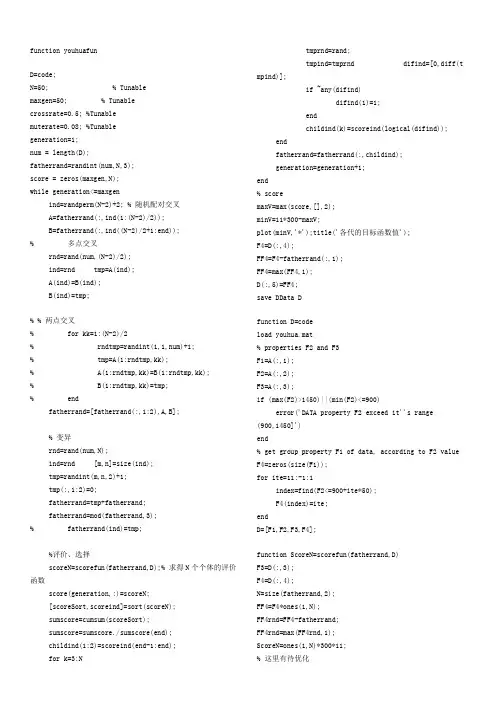
function youhuafunD=code;N=50; % Tunablemaxgen=50; % Tunablecrossrate=0.5; %Tunablemuterate=0.08; %Tunablegeneration=1;num = length(D);fatherrand=randint(num,N,3);score = zeros(maxgen,N);while generation<=maxgenind=randperm(N-2)+2; % 随机配对交叉A=fatherrand(:,ind(1:(N-2)/2));B=fatherrand(:,ind((N-2)/2+1:end));% 多点交叉rnd=rand(num,(N-2)/2);ind=rnd tmp=A(ind);A(ind)=B(ind);B(ind)=tmp;% % 两点交叉% for kk=1:(N-2)/2% rndtmp=randint(1,1,num)+1;% tmp=A(1:rndtmp,kk);% A(1:rndtmp,kk)=B(1:rndtmp,kk);% B(1:rndtmp,kk)=tmp;% endfatherrand=[fatherrand(:,1:2),A,B];% 变异rnd=rand(num,N);ind=rnd [m,n]=size(ind);tmp=randint(m,n,2)+1;tmp(:,1:2)=0;fatherrand=tmp+fatherrand;fatherrand=mod(fatherrand,3);% fatherrand(ind)=tmp;%评价、选择scoreN=scorefun(fatherrand,D);% 求得N个个体的评价函数score(generation,:)=scoreN;[scoreSort,scoreind]=sort(scoreN);sumscore=cumsum(scoreSort);sumscore=sumscore./sumscore(end);childind(1:2)=scoreind(end-1:end);for k=3:N tmprnd=rand;tmpind=tmprnd difind=[0,diff(tmpind)];if ~any(difind)difind(1)=1;endchildind(k)=scoreind(logical(difind));endfatherrand=fatherrand(:,childind);generation=generation+1;end% scoremaxV=max(score,[],2);minV=11*300-maxV;plot(minV,'*');title('各代的目标函数值');F4=D(:,4);FF4=F4-fatherrand(:,1);FF4=max(FF4,1);D(:,5)=FF4;save DData Dfunction D=codeload youhua.mat% properties F2 and F3F1=A(:,1);F2=A(:,2);F3=A(:,3);if (max(F2)>1450)||(min(F2)<=900)error('DATA property F2 exceed it''s range (900,1450]') end% get group property F1 of data, according to F2 value F4=zeros(size(F1));for ite=11:-1:1index=find(F2<=900+ite*50);F4(index)=ite;endD=[F1,F2,F3,F4];function ScoreN=scorefun(fatherrand,D)F3=D(:,3);F4=D(:,4);N=size(fatherrand,2);FF4=F4*ones(1,N);FF4rnd=FF4-fatherrand;FF4rnd=max(FF4rnd,1);ScoreN=ones(1,N)*300*11;% 这里有待优化for k=1:NFF4k=FF4rnd(:,k);for ite=1:11F0index=find(FF4k==ite);if ~isempty(F0index)tmpMat=F3(F0index);tmpSco=sum(tmpMat);ScoreBin(ite)=mod(tmpSco,300);endendScorek(k)=sum(ScoreBin);endScoreN=ScoreN-Scorek;遗传算法实例:% 下面举例说明遗传算法%% 求下列函数的最大值%% f(x)=10*sin(5x)+7*cos(4x) x∈[0,10] %% 将x 的值用一个10位的二值形式表示为二值问题,一个10位的二值数提供的分辨率是每为(10-0)/(2^10-1)≈0.01 。

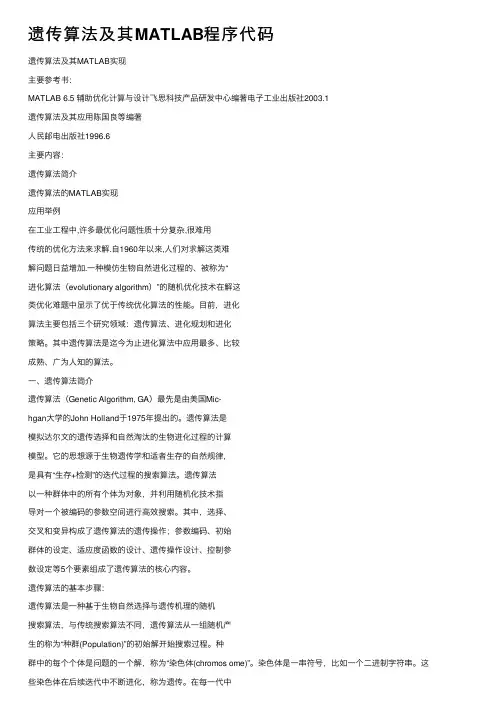
遗传算法及其MATLAB程序代码遗传算法及其MATLAB实现主要参考书:MATLAB 6.5 辅助优化计算与设计飞思科技产品研发中⼼编著电⼦⼯业出版社2003.1遗传算法及其应⽤陈国良等编著⼈民邮电出版社1996.6主要内容:遗传算法简介遗传算法的MATLAB实现应⽤举例在⼯业⼯程中,许多最优化问题性质⼗分复杂,很难⽤传统的优化⽅法来求解.⾃1960年以来,⼈们对求解这类难解问题⽇益增加.⼀种模仿⽣物⾃然进化过程的、被称为“进化算法(evolutionary algorithm)”的随机优化技术在解这类优化难题中显⽰了优于传统优化算法的性能。
⽬前,进化算法主要包括三个研究领域:遗传算法、进化规划和进化策略。
其中遗传算法是迄今为⽌进化算法中应⽤最多、⽐较成熟、⼴为⼈知的算法。
⼀、遗传算法简介遗传算法(Genetic Algorithm, GA)最先是由美国Mic-hgan⼤学的John Holland于1975年提出的。
遗传算法是模拟达尔⽂的遗传选择和⾃然淘汰的⽣物进化过程的计算模型。
它的思想源于⽣物遗传学和适者⽣存的⾃然规律,是具有“⽣存+检测”的迭代过程的搜索算法。
遗传算法以⼀种群体中的所有个体为对象,并利⽤随机化技术指导对⼀个被编码的参数空间进⾏⾼效搜索。
其中,选择、交叉和变异构成了遗传算法的遗传操作;参数编码、初始群体的设定、适应度函数的设计、遗传操作设计、控制参数设定等5个要素组成了遗传算法的核⼼内容。
遗传算法的基本步骤:遗传算法是⼀种基于⽣物⾃然选择与遗传机理的随机搜索算法,与传统搜索算法不同,遗传算法从⼀组随机产⽣的称为“种群(Population)”的初始解开始搜索过程。
种群中的每个个体是问题的⼀个解,称为“染⾊体(chromos ome)”。
染⾊体是⼀串符号,⽐如⼀个⼆进制字符串。
这些染⾊体在后续迭代中不断进化,称为遗传。
在每⼀代中⽤“适值(fitness)”来测量染⾊体的好坏,⽣成的下⼀代染⾊体称为后代(offspring)。

方案一的程序编码函数主文件:function[Xp,LC1,LC2,LC3]=CLBGA8(M,Pm) %%%陈璐斌编程,解决VRP问题(带时间窗)%%输入参数%M遗传进化迭代次数%Pm变异概率%%输出参数%Xp最优个体%LC1目标收敛曲线%LC2平均适应度收敛曲线%LC3最优适应度收敛曲线%%%变量初始化Xp=zeros(1,5);LC1=zeros(1,M);LC2=zeros(1,M);LC3=zeros(1,M);Best=inf;%%编码方式-第一步:产生初始种群N=10;%N 种群规模farm=cell(1,N);%存储种群的细胞结构k=1;while (N-k>=0)G=randperm(5);%产生5个客户的全排列farm{k}=G;k=k+1;end%%%进化迭代计数器counter=1;while counter<=M%%第二步:交叉%交叉采用双亲双子单点交叉N=10;%种群规模newfarm=cell(1,2*N-4);%存储子代的细胞结构Ser=randperm(N);%两两随机配对表生成for i=1:(N-2)%避免交叉概率为1 A=farm{Ser(i)};B=farm{Ser(i+1)};%取出父代P0=unidrnd(5);%随机选择交叉点aa=zeros(1,5);bb=zeros(1,5);A_=A;B_=B;for ii=1:5-P0aa(ii)=B(P0+ii);endfor ii=1:5-P0for iiii=1:5if(B(P0+ii)==A_(iiii))A_(iiii)=0;endendendfor iii=6-P0:5for iiii=1:5if(A_(iiii)~=0)aa(iii)=A_(iiii);A_(iiii)=0;breakendendendfor ii=1:5-P0bb(ii)=A(P0+ii);endfor ii=1:5-P0for iiii=1:5if(A(P0+ii)==B_(iiii))B_(iiii)=0;endendendfor iii=6-P0:5for iiii=1:5if(B_(iiii)~=0)bb(iii)=B_(iiii);B_(iiii)=0;breakendendend%产生子代newfarm{2*i-1}=aa;newfarm{2*i}=bb;endFARM=[farm,newfarm];%新旧种群合并%%第三步:选择复制%%计算当前种群适应度并存储N=10;SYZ=zeros(1,3*N-4);syz=zeros(1,3*N-4);for i=1:(3*N-4)x=FARM{i};SYZ(i)=clb8(x);end%%选择复制,较优的N个个体复制到下一代k=1;while k<=(3*N-4)maxSYZ=max(SYZ);posSYZ=find(SYZ==maxSYZ);POS=posSYZ(1);k=k+1;farm{k}=FARM{POS};syz(k)=SYZ(POS);SYZ(POS)=0;end%记录和更新,更新最优个体,记录收敛曲线数据maxsyz=max(syz);meansyz=mean(syz);pos=find(syz==maxsyz);LC2(counter+1)=meansyz;if maxsyzBest=maxsyz;Xp=farm{pos(1)};endLC3(counter+1)=Best;d=[0,6.4,3.2,3.9,3.7,2;6.4,0,2.9,2.1,4.5,4.1;3.2,2.9,0,1.5,3.3,1.2;3.9,2.1,1.5,0,3.6,2.6;3.7,4.5,3.3,3.6 ,0,3.8;...2.0,4.1,1.2,2.6,3.8,0;];%距离矩阵t=[0,0.16,0.08,0.1,0.09,0.05;0.16,0,0.07,0.05,0.11,0.1;0.08,0.07,0,0.04,0.08,0.03;...0.1,0.05,0.04,0,0.09,0.07;0.09,0.11,0.08,0.09,0,0.10;0.05,0.1,0.03,0.07,0.1,0;];%行驶时间矩阵w=[0.15,0.2,0.18,0.25,0.22];%服务时间矩阵%%时间窗向量early=[0.15,0.3,0.7,0.4,0.7];xx=x;%取出染色体j=1;%分工点初始化%%取距离向量d1,d2d1=zeros(1,6);d1(1)=d(1,xx(1)+1);for i=1:4d1(i+1)=d(xx(i)+1,xx(i+1)+1);endd1(6)=d(xx(5)+1,1);%%时间窗计算T=t(1,xx(1)+1);pun1=0;if T<early(xx(1))pun1=early(xx(1))-T;T=early(xx(1));endT=T+w(xx(1));for i=2:5T=T+t(xx(i-1)+1,xx(i)+1);if T<early(xx(i))pun1=pun1+early(xx(i))-T;T=early(xx(i));endT=T+w(xx(5));endF=sum(10.*d1)+sum(10.*d2)+20*pun1; LC1(counter+1)=F;%%第四步:变异N=10;for i=1:Nif Pm>randAA=farm{i};POS1=unidrnd(5);POS2=unidrnd(5);temp=AA(POS1);AA(POS1)=AA(POS2);AA(POS2)=temp;farm{i}=AA;endendcounter=counter+1;end%%第五步:绘制收敛曲线图figure(2);plot(LC1);xlabel('迭代次数');ylabel('目标的值');title('目标的收敛曲线');figure(3);plot(LC2);xlabel('迭代次数');ylabel('适应度函数的平均值');title('平均适应度函数的收敛曲线');plot(LC3);xlabel('迭代次数');ylabel('适应度函数的最优值');title('最优适应度函数的收敛曲线');适应度文件:%%计算载重量和时间窗%%适应度函数计算function Fitness=clb8(x)d=[0,6.4,3.2,3.9,3.7,2;6.4,0,2.9,2.1,4.5,4.1;3.2,2.9,0,1.5,3.3,1.2;3.9,2.1,1.5,0,3.6,2.6;3.7,4.5,3.3,3.6 ,0,3.8;...2.0,4.1,1.2,2.6,3.8,0;];%距离矩阵t=[0,0.16,0.08,0.1,0.09,0.05;0.16,0,0.07,0.05,0.11,0.1;0.08,0.07,0,0.04,0.08,0.03;...0.1,0.05,0.04,0,0.09,0.07;0.09,0.11,0.08,0.09,0,0.10;0.05,0.1,0.03,0.07,0.1,0;];%行驶时间矩阵w=[0.15,0.2,0.18,0.25,0.22];%服务时间矩阵%%时间窗向量early=[0.15,0.3,0.7,0.4,0.7];xx=x;%取出染色体j=1;%分工点初始化%%取距离向量d1,d2d1=zeros(1,6);d1(1)=d(1,xx(1)+1);for i=1:4d1(i+1)=d(xx(i)+1,xx(i+1)+1);endd1(6)=d(xx(5)+1,1);%%时间窗计算T=t(1,xx(1)+1);pun1=0;if T<early(xx(1))pun1=early(xx(1))-T;T=early(xx(1));endT=T+w(xx(1));T=T+t(xx(i-1)+1,xx(i)+1);if T<early(xx(i))pun1=pun1+early(xx(i))-T;T=early(xx(i));endT=T+w(xx(5));endF=sum(10.*d1)+sum(10.*d2)+20*pun1;Fitness=1/F;计算时间文件:function[T]=TOTALT(Xp1)Xp=Xp1;t=[0,0.16,0.08,0.1,0.09,0.05;0.16,0,0.07,0.05,0.11,0.1;0.08,0.07,0,0.04,0.08,0.03;...0.1,0.05,0.04,0,0.09,0.07;0.09,0.11,0.08,0.09,0,0.10;0.05,0.1,0.03,0.07,0.1,0;];%行驶时间矩阵w=[0.15,0.2,0.18,0.25,0.22];%服务时间矩阵%%时间窗向量early=[0.15,0.3,0.7,0.4,0.7];T=t(1,Xp(1)+1);if T<early(Xp(1))T=early(Xp(1));endT=T+w(Xp(1));for i=2:5T=T+t(Xp(i-1)+1,Xp(i)+1);if T<early(Xp(i))T=early(Xp(1));endT=T+w(Xp(i));endT=T+t(1,Xp(5)+1);方案二的程序编码主函数文件:function[Xp,LC1,LC2,LC3]=CLBGA9(M,Pm)%%%陈璐斌编程,解决VRP问题(带时间窗)%%输入参数%M遗传进化迭代次数%Pm变异概率%%输出参数%Xp最优个体%LC1子目标2收敛曲线%LC2平均适应度收敛曲线%LC3最优适应度收敛曲线%%%变量初始化Xp=zeros(1,6);LC1=zeros(1,M);LC2=zeros(1,M);LC3=zeros(1,M);Best=inf;%%编码方式-第一步:产生初始种群N=10;%N 种群规模%Q=[2.4,3.3,2.1,2.7,2.3,1.6,2.0,1.2,3.6,1.9];%需求矩阵farm=cell(1,N);%存储种群的细胞结构k=1;while (N-k>=0)G=randperm(6);%产生6个客户的全排列farm{k}=G;k=k+1;end%%%进化迭代计数器counter=1;while counter<=M%%第二步:交叉%交叉采用双亲双子单点交叉N=10;%种群规模newfarm=cell(1,2*N-4);%存储子代的细胞结构Ser=randperm(N);%两两随机配对表生成for i=1:(N-2)%避免交叉概率为1A=farm{Ser(i)};B=farm{Ser(i+1)};%取出父代P0=unidrnd(6);%随机选择交叉点aa=zeros(1,6);bb=zeros(1,6);A_=A;B_=B;for ii=1:6-P0aa(ii)=B(P0+ii);endfor ii=1:6-P0for iiii=1:6if(B(P0+ii)==A_(iiii))A_(iiii)=0;endendendfor iii=7-P0:6for iiii=1:6if(A_(iiii)~=0)aa(iii)=A_(iiii);A_(iiii)=0;breakendendendfor ii=1:6-P0bb(ii)=A(P0+ii);endfor ii=1:6-P0for iiii=1:6if(A(P0+ii)==B_(iiii))B_(iiii)=0;endendendfor iii=7-P0:6for iiii=1:6if(B_(iiii)~=0)bb(iii)=B_(iiii);B_(iiii)=0;breakendendend%产生子代newfarm{2*i-1}=aa;newfarm{2*i}=bb;endFARM=[farm,newfarm];%新旧种群合并%%第三步:选择复制%%计算当前种群适应度并存储N=10;SYZ=zeros(1,3*N-4);syz=zeros(1,3*N-4);for i=1:(3*N-4)x=FARM{i};SYZ(i)=clb9(x);end%%选择复制,较优的N个个体复制到下一代k=1;while k<=(3*N-4)maxSYZ=max(SYZ);posSYZ=find(SYZ==maxSYZ);POS=posSYZ(1);k=k+1;farm{k}=FARM{POS};syz(k)=SYZ(POS);SYZ(POS)=0;end%记录和更新,更新最优个体,记录收敛曲线数据maxsyz=max(syz);meansyz=mean(syz);pos=find(syz==maxsyz);LC2(counter+1)=meansyz;if maxsyzBest=maxsyz;Xp=farm{pos(1)};endLC3(counter+1)=Best;d=[0,6.4,3.2,3.9,3.7,35,2;6.4,0,2.9,2.1,4.5,32.5,4.1;3.2,2.9,0,1.5,3.3,35.7,1.2;3.9,2.1,1.5,0,3.6,34.5,2.6;...3.7,4.5,3.3,3.6,0,37,3.8;35,32.5,35.7,34.5,37,0,38.5;2,4.1,1.2,2.6,3.8,38.5,0];%距离矩阵t=[0,0.16,0.08,0.1,0.1,0.88,0.05;0.16,0,0.07,0.05,0.11,0.81,0.1;0.08,0.07,0,0.04,0.08,0.9,0.03;...0.1,0.05,0.04,0,0.09,0.86,0.07;0.1,0.11,0.08,0.09,0,0.92,0.1;0.88,0.81,0.9,0.86,0.92,0,0.96;...0.05,0.1,0.03,0.07,0.1,0.96,0;];%行驶时间矩阵w=[0.15,0.2,0.18,0.25,0.2,0.22];%服务时间矩阵%%时间窗向量early=[0.15,0.3,0.7,0.4,0.7,0.6];xx=x;%取出染色体j=1;%分工点初始化%%取距离向量d1,d2d1=zeros(1,7);d1(1)=d(1,xx(1)+1);for i=1:5d1(i+1)=d(xx(i)+1,xx(i+1)+1);endd1(7)=d(xx(6)+1,1);%%时间窗计算T=t(1,xx(1)+1);pun1=0;if T<early(xx(1))pun1=early(xx(1))-T;T=early(xx(1));endT=T+w(xx(1));for i=2:6T=T+t(xx(i-1)+1,xx(i)+1);if T<early(xx(i))pun1=pun1+early(xx(i))-T;T=early(xx(i));endT=T+w(xx(6));endF=sum(10.*d1) +20*pun1;LC1(counter+1)=F;%%第四步:变异N=10;for i=1:Nif Pm>randAA=farm{i};POS1=unidrnd(6);POS2=unidrnd(6);temp=AA(POS1);AA(POS1)=AA(POS2);AA(POS2)=temp;farm{i}=AA;endendcounter=counter+1;end%%第五步:绘制收敛曲线图figure(2);plot(LC1);xlabel('迭代次数');ylabel('目标的值');title('目标的收敛曲线');figure(3);plot(LC2);xlabel('迭代次数');ylabel('适应度函数的平均值');title('平均适应度函数的收敛曲线');figure(4);plot(LC3);xlabel('迭代次数');ylabel('适应度函数的最优值');title('最优适应度函数的收敛曲线');适应度文件:%%计算载重量和时间窗%%适应度函数计算function Fitness=clb9(x)d=[0,6.4,3.2,3.9,3.7,35,2;6.4,0,2.9,2.1,4.5,32.5,4.1;3.2,2.9,0,1.5,3.3,35.7,1.2;3.9,2.1,1.5,0,3.6,34.5,2.6;...3.7,4.5,3.3,3.6,0,37,3.8;35,32.5,35.7,34.5,37,0,38.5;2,4.1,1.2,2.6,3.8,38.5,0];%距离矩阵t=[0,0.16,0.08,0.1,0.1,0.88,0.05;0.16,0,0.07,0.05,0.11,0.81,0.1;0.08,0.07,0,0.04,0.08,0.9,0.03;...0.1,0.05,0.04,0,0.09,0.86,0.07;0.1,0.11,0.08,0.09,0,0.92,0.1;0.88,0.81,0.9,0.86,0.92,0,0.96;...0.05,0.1,0.03,0.07,0.1,0.96,0;];%行驶时间矩阵w=[0.15,0.2,0.18,0.25,0.2,0.22];%服务时间矩阵%%时间窗向量early=[0.15,0.3,0.7,0.4,0.7,0.6];late=[2.5,3.4,3.3,2.7,2.5,4.5];xx=x;%取出染色体j=1;%分工点初始化%%取距离向量d1,d2d1=zeros(1,7);d1(1)=d(1,xx(1)+1);for i=1:5d1(i+1)=d(xx(i)+1,xx(i+1)+1);endd1(7)=d(xx(6)+1,1);%%时间窗计算T=t(1,xx(1)+1);pun1=0;if T<early(xx(1))pun1=early(xx(1))-T;T=early(xx(1));endT=T+w(xx(1));for i=2:6T=T+t(xx(i-1)+1,xx(i)+1);if T<early(xx(i))pun1=pun1+early(xx(i))-T;T=early(xx(i));endT=T+w(xx(6));endF=sum(10.*d1) +20*pun1;Fitness=1/F;计算时间文件:function[T]=TOTALT2(Xp1)Xp=Xp1;t=[0,0.16,0.08,0.1,0.1,0.88,0.05;0.16,0,0.07,0.05,0.11,0.81,0.1;0.08,0.07,0,0.04,0.08,0.9,0.03;...0.1,0.05,0.04,0,0.09,0.86,0.07;0.1,0.11,0.08,0.09,0,0.92,0.1;0.88,0.81,0.9,0.86,0.92,0,0.96;... 0.05,0.1,0.03,0.07,0.1,0.96,0;];%行驶时间矩阵w=[0.15,0.2,0.18,0.25,0.2,0.22];%服务时间矩阵%%时间窗向量early=[0.15,0.3,0.7,0.4,0.7,0.6];T=t(1,Xp(1)+1);if T<early(Xp(1))T=early(Xp(1));endT=T+w(Xp(1));for i=2:6T=T+t(Xp(i-1)+1,Xp(i)+1);if T<early(Xp(i))T=early(Xp(1));endT=T+w(Xp(i));endT=T+t(1,Xp(6)+1)。
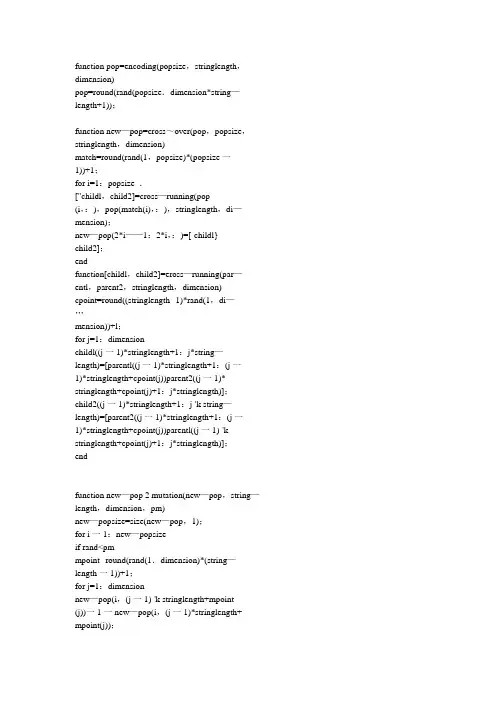
function pop=encoding(popsize,stringlength,dimension)pop=round(rand(popsize.dimension*string—length+1));function new—pop=cross~over(pop,popsize,stringlength,dimension)match=round(rand(1,popsize)*(popsize一1))+1;for i=1:popsize .["childl,child2]=cross—running(pop (i,:),pop(match(i),:),stringlength,di—mension);new—pop(2*i——1:2*i,:)=[-childl}child2];endfunction[childl,child2]=eross—running(par—entl,parent2,stringlength,dimension)cpoint=round((stringlength--1)*rand(1,di—…mension))+l;for j=1:dimensionchildl((j一1)*stringlength+1:j*string—length)=[parentl((j一1)*stringlength+1:(j一1)*stringlength+cpoint(j))parent2((j一1)* stringlength+cpoint(j)+1:j*stringlength)];child2((j一1)*stringlength+1:j-'k string—length)=[parent2((j一1)*stringlength+1:(j一1)*stringlength+cpoint(j))parentl((j一1)-'k stringlength+cpoint(j)+1:j*stringlength)];endfunction new—pop 2 mutation(new—pop,string—length,dimension,pm)new—popsize=size(new—pop,1);for i一1:new—popsizeif rand<pmmpoint--round(rand(1.dimension)*(string—length一1))+1;for j=1:dimensionnew—pop(i,(j一1)-'k stringlength+mpoint (j))一1一new—pop(i,(j一1)*stringlength+ mpoint(j));endendendfunction pop—decoding(pop,stringlength,dimen—sion,X—bound)popsize=size(pop,1);temp--2.‘(stringlength一1:一1:0)/(2‘string—length--1);for i一1:dimensionbound(i)=X—bound(i,2)一x—bound(i,1);endfor i=1:popsizeforj=1:dimensionm(:,j)一pop(i,stringlength*(j一1)+1:stringlength*j);endx2temp*m ox—x.*bound+x—bound(:,1)’;’pop(i,dimension*stringlength+1)一funname (x);Endfunction selected=selection(pop,popsize,string—length,dimension)popsize—new2size(pop,1);r=rand(1,popsize):fitness=pop(:,dimension*stringlength+1);fitness=fitness/sum(fitness);fitness=cumsum(fitness);for i=l:popsizef0√~1:popsize~newi j--a.“if,(i)三:fit:00110110,则解码后selected(i':) ,,‘。
MATLAB实现算法代码:GA(遗传算法)——整数编码function [BestGene,aa] = GA(MaxGeneration,GeneSize,GeneNum,pcross,pmute,minGene,maxGene)Parent = Init(GeneSize,GeneNum,minGene,maxGene);[BestGene,Parent] = KeepBest(Parent);aa = [];for i = 1:MaxGeneration[i 1/value(BestGene)]Child = chose(Parent);Child = cross(Child,pcross);Child = mute(Child,pmute,maxGene);[BestGene,Parent] = KeepBest(Child);aa = [aa;value(BestGene)];endfunction GeneInit = Init(GeneSize,GeneNum,minGene,maxGene)GeneInit = [];for i = 1:GeneSizex = []; x = ceil(rand(1,GeneNum).*(maxGene-minGene)) + minGene;GeneInit = [GeneInit;x];endGeneInit = [GeneInit;x];function Child = chose(Parent)GeneSize = size(Parent,1);for i = 1:GeneSizex = Parent(i,:);val(i) = value(x);endValSum = sum(val);val = val / ValSum;for i = 2:GeneSizeval(i) = val(i) + val(i-1);endfor i = 1:GeneSizerandval = rand;if randval <= val(1)Child(i,:) = Parent(1,:);endfor j = 2:GeneSizeif randval > val(j-1) && randval <= val(j)Child(i,:) = Parent(j,:);break;endendendChild(end,:) = Parent(end,:);function Child = cross(Parent,pcross)[GeneSize,GeneNum] = size(Parent);GeneSize = GeneSize - 1;Child = Parent;for i = 1:GeneSize/2if rand < pcrossflag = 0;while( flag==0 )randval1 = floor((GeneNum-1)*rand) + 1;randval2 = floor((GeneNum-1)*rand) + 1;if randval1 ~= randval2flag = 1;endendtemp = Child(2*i-1,randval1:randval2);Child(2*i-1,randval1:randval2) = Child(2*i,randval1:randval2);Child(2*i,randval1:randval2) = temp;endendfunction Child = mute(Parent,pmute,maxGene)[GeneSize,GeneNum] = size(Parent);GeneSize = GeneSize - 1;Child = Parent;for i = 1:GeneSizeif rand < pmuterandval = ceil((GeneNum-1)*rand) + 1;Child(i,randval) = maxGene(randval) - Child(i,randval) + 1;endendfunction [BestGene,Parent] = KeepBest(Child)[GeneSize,GeneNum] = size(Child);for i = 1:GeneSizex = Child(i,:);val(i) = value(x);endBigVal = val(1);flag = 1;for i = 2:GeneSizeif BigVal < val(i)BigVal = val(i);flag = i;endendBestGene = Child(flag,:); Parent = Child;Parent(1,:) = BestGene; Parent(end,:) = BestGene;。
遗传算法的matlab代码摘要:遗传算法是一种基于自然选择和遗传学原理的优化算法。
本文将介绍如何在MATLAB中实现遗传算法,并使用一个简单的例子来说明其应用。
1. 引言遗传算法(Genetic Algorithm, GA)是一种基于自然选择和遗传学原理的优化算法。
它模拟了自然界中生物的进化过程,通过不断地搜索、适应和优化,最终找到问题的最优解。
MATLAB是一种广泛使用的编程语言和软件环境,它提供了丰富的数学计算和可视化工具,使得在MATLAB中实现遗传算法变得相对简单。
2. 遗传算法的基本原理遗传算法主要包括以下几个步骤:1) 初始化:随机生成一组候选解(称为种qun)。
2) 选择:从种qun中按照一定的概率选择出优秀的个体进行繁殖。
3) 交叉:从选择出的个体中随机选择两个进行交叉操作,生成新的后代。
4) 变异:对后代进行变异操作,以增大种qun的多样性。
5) 迭代:重复进行选择、交叉和变异操作,直到达到预设的迭代次数或满足其他终止条件。
3. MATLAB实现遗传算法在MATLAB中实现遗传算法,可以使用自带的gaoptimset和ga函数。
下面是一个简单的例子,说明如何在MATLAB中实现遗传算法。
```matlab```% 定义目标函数fitnessFunction = @(x) x(1)^2 + x(2)^2; % 最小化目标函数```% 定义变量范围lb = [-10, -10]; % 变量下界ub = [10, 10]; % 变量上界```% 初始化参数populationSize = 100; % 种qun大小maxIterations = 500; % 最da迭代次数crossoverRate = 0.8; % 交叉概率mutationRate = 0.1; % 变异概率elitismRate = 0.1; % 精英策略概率```% 初始化种qunpopulation = ga(fitnessFunction, lb, ub, populationSize, maxIterations, elitismRate, crossoverRate, mutationRate);```% 可视化结果figure;plot(population.Fitness,'r');hold on;plot(population.Gen,'g');xlabel('Generation');ylabel('Fitness');title('遗传算法进化过程');```4. 结果分析通过上述代码,我们可以在MATLAB中实现一个简单的遗传算法。
clc;clear;%各份订单基本数据phen=[1 2 3 4 5 6 7 8 9 10 11 12 13 1441,52,-23,-46,-143,-74,-56,101,73,74,95,86,-35,3265,23,-76,104,34,38,4,-23,55,-49,39,89,-86,527716,9887,12188,8819,4002,6119,3284,4607,5600,4587,9821,13024,6547,26 84500,400,1000,120,0,235,654,241,0,361,120,254,300,1501,4,2,2,4,4,3,3,3,1,4,5,1,32.7,1.8,4,2.5,1.6,1,3.6,5,4.2,1.9,6.4,2.8,1.4,8];hromlength=14;popsize=30;maxgen=500; p c=0.8;pm=0.04;for kem=1:popsizepopulation(kem,:)=randperm(hromlength);endpopulation;%评价目标函数值for uim=1:popsizevector=population(uim,:);obj(uim)=hanshu(hromlength,vector,phen);end%obj%min(obj)clear uim;objmin=min(obj);for sequ=1:popsizeif obj(sequ)==objminopti=population(sequ,:);endendclear sequ;fmax=22000;%==for gen=1:maxgen%选择操作%将求最小值的函数转化为适应度函数for indivi=1:popsizeobj1(indivi)=1/obj(indivi);endclear indivi;%适应度函数累加总合total=0;for indivi=1:popsizetotal=total+obj1(indivi);endclear indivi;%每条染色体被选中的几率for indivi=1:popsizefitness1(indivi)=obj1(indivi)/total;endclear indivi;%各条染色体被选中的范围for indivi=1:popsizefitness(indivi)=0;for j=1:indivifitness(indivi)=fitness(indivi)+fitness1(j);endendclear j;fitness;%选择适应度高的个体for ranseti=1:popsizeran=rand;while (ran>1||ran<0)ran=rand;endran;if ran<=fitness(1)newpopulation(ranseti,:)=population(1,:);elsefor fet=2:popsizeif (ran>fitness(fet-1))&&(ran<=fitness(fet))newpopulation(ranseti,:)=population(fe t,:);endendendendclear ran;newpopulation;%交叉for int=1:2:popsize-1popmoth=newpopulation(int,:);popfath=newpopulation(int+1,:);popcross(int,:)=popmoth;popcross(int+1,:)=popfath;randnum=rand;if(randnum< P>cpoint1=round(rand*hromlength);cpoint2=round(rand*hromlength);while (cpoint2==cpoint1)cpoint2=round(rand*hromlength);endif cpoint1>cpoint2tem=cpoint1;cpoint1=cpoint2;cpoint2=tem;endcpoint1;cpoint2;for term=cpoint1+1:cpoint2for ss=1:hromlengthif popcross(int,ss)==popfath(term)tem1=popcross(int,ss);popcross(int,ss)=popcross(int, term);popcross(int,term)=tem1;endendclear tem1;endfor term=cpoint1+1:cpoint2for ss=1:hromlengthif popcross(int+1,ss)==popmoth(term)tem1=popcross(int+1,ss);popcross(int+1,ss)=popcross(in t+1,term);popcross(int+1,term)=tem1;endendclear tem1;endendclear term;endclear randnum;popcross;%变异操作newpop=popcross;for int=1:popsizerandnum=rand;if randnumcpoint12=round(rand*hromlength);cpoint22=round(rand*hromlength);if (cpoint12==0)cpoint12=1;endif (cpoint22==0)cpoint22=1;endwhile (cpoint22==cpoint12)cpoint22=round(rand*hromlength);if cpoint22==0;cpoint22=1;endendtemp=newpop(int,cpoint12);newpop(int,cpoint12)=newpop(int,cpoint22);newpop(int,cpoint22)=temp;endendnewpop;clear cpoint12;clear cpoint22;clear randnum;clear int;for ium=1:popsizevector1=newpop(ium,:);obj1(ium)=hanshu(hromlength,vector1,phen); endclear ium;obj1max=max(obj1);for ar=1:popsizeif obj1(ar)==obj1maxnewpop(ar,:)=opti;endendclear population;clear objmin;clear objmean;%遗传操作结束population=newpop;for ium=1:popsizevector2=population(ium,:);obj(ium)=object(hromlength,vector2,phen); endobjmin=min(obj);objmean=mean(obj);clear opti;for sequ1=1:popsizeif obj(sequ1)==objminopti=population(sequ1,:);endendsolution=objmin;final(gen)=objmin;final1(gen)=objmean;endoptisolutionplot(final);hold on;plot(final1,'--')hold off%目标函数值子函数function[cost]=hanshu(hromlength,vector,phen)wmax=20000;ct=1.2;ch=0.5;for num=1:hromlengthline=vector(num);s(:,num)=phen(:,line);endm=1;cshort=0;chold=0;ctrans=0;while m<=hromlengthj=m;weight=s(4,j);day=s(6,j);dis=sqrt(s(2,j)^2+s(3,j)^2);while ((j< P>weight=weight+s(4,j+1);if (s(6,j+1)< P>cshort=(s(5,j+1))*(s(7,j+1))*0.1+cshor t;chold=(s(4,j+1))*ch+chold;enddis=sqrt((s(2,j)-s(2,j+1))^2+(s(3,j)-s(3,j+1)) ^2);j=j+1;enddis=dis+sqrt(s(2,j)^2+s(3,j)^2);ctrans=ctrans+dis*weight*ct;m=j+1;endcost=cshort+chold+ctrans;。
function youhuafunD=code;N=50; % Tunablemaxgen=50; % Tunablecrossrate=0.5; %Tunablemuterate=0.08; %Tunablegeneration=1;num = length(D);fatherrand=randint(num,N,3);score = zeros(maxgen,N);while generation<=maxgenind=randperm(N-2)+2; % 随机配对交叉A=fatherrand(:,ind(1:(N-2)/2));B=fatherrand(:,ind((N-2)/2+1:end));% 多点交叉rnd=rand(num,(N-2)/2);ind=rnd tmp=A(ind);A(ind)=B(ind);B(ind)=tmp;% % 两点交叉% for kk=1:(N-2)/2% rndtmp=randint(1,1,num)+1;% tmp=A(1:rndtmp,kk);% A(1:rndtmp,kk)=B(1:rndtmp,kk);% B(1:rndtmp,kk)=tmp;% endfatherrand=[fatherrand(:,1:2),A,B];% 变异rnd=rand(num,N);ind=rnd [m,n]=size(ind);tmp=randint(m,n,2)+1;tmp(:,1:2)=0;fatherrand=tmp+fatherrand;fatherrand=mod(fatherrand,3);% fatherrand(ind)=tmp;%评价、选择scoreN=scorefun(fatherrand,D);% 求得N个个体的评价函数score(generation,:)=scoreN;[scoreSort,scoreind]=sort(scoreN);sumscore=cumsum(scoreSort);sumscore=sumscore./sumscore(end);childind(1:2)=scoreind(end-1:end);for k=3:Ntmprnd=rand;tmpind=tmprnd difind=[0,diff(tmpind)];if ~any(difind)difind(1)=1;endchildind(k)=scoreind(logical(difind));endfatherrand=fatherrand(:,childind);generation=generation+1;end% scoremaxV=max(score,[],2);minV=11*300-maxV;plot(minV,'*');title('各代的目标函数值');F4=D(:,4);FF4=F4-fatherrand(:,1);FF4=max(FF4,1);D(:,5)=FF4;save DData Dfunction D=codeload youhua.mat% properties F2 and F3F1=A(:,1);F2=A(:,2);F3=A(:,3);if (max(F2)>1450)||(min(F2)<=900)error('DATA property F2 exceed it''s range (900,1450]') end% get group property F1 of data, according to F2 value F4=zeros(size(F1));for ite=11:-1:1index=find(F2<=900+ite*50);F4(index)=ite;endD=[F1,F2,F3,F4];function ScoreN=scorefun(fatherrand,D)F3=D(:,3);F4=D(:,4);N=size(fatherrand,2);FF4=F4*ones(1,N);FF4rnd=FF4-fatherrand;FF4rnd=max(FF4rnd,1);ScoreN=ones(1,N)*300*11;% 这里有待优化for k=1:NFF4k=FF4rnd(:,k);for ite=1:11F0index=find(FF4k==ite);if ~isempty(F0index)tmpMat=F3(F0index);tmpSco=sum(tmpMat);ScoreBin(ite)=mod(tmpSco,300);endendScorek(k)=sum(ScoreBin);endScoreN=ScoreN-Scorek;遗传算法实例:% 下面举例说明遗传算法%% 求下列函数的最大值%% f(x)=10*sin(5x)+7*cos(4x) x∈[0,10] %% 将x 的值用一个10位的二值形式表示为二值问题,一个10位的二值数提供的分辨率是每为(10-0)/(2^10-1)≈0.01 。
function youhuafunD=code;N=50; % Tunablemaxgen=50; % Tunablecrossrate=0.5; %Tunablemuterate=0.08; %Tunablegeneration=1;num = length(D);fatherrand=randint(num,N,3);score = zeros(maxgen,N);while generation<=maxgenind=randperm(N-2)+2; % 随机配对交叉A=fatherrand(:,ind(1:(N-2)/2));B=fatherrand(:,ind((N-2)/2+1:end));% 多点交叉rnd=rand(num,(N-2)/2);ind=rnd tmp=A(ind);A(ind)=B(ind);B(ind)=tmp;% % 两点交叉% for kk=1:(N-2)/2% rndtmp=randint(1,1,num)+1; % tmp=A(1:rndtmp,kk);% A(1:rndtmp,kk)=B(1:rndtmp,kk);% B(1:rndtmp,kk)=tmp;% endfatherrand=[fatherrand(:,1:2),A,B];% 变异rnd=rand(num,N);ind=rnd [m,n]=size(ind);tmp=randint(m,n,2)+1;tmp(:,1:2)=0;fatherrand=tmp+fatherrand;fatherrand=mod(fatherrand,3);% fatherrand(ind)=tmp;%评价、选择scoreN=scorefun(fatherrand,D);% 求得N个个体的评价函数score(generation,:)=scoreN;[scoreSort,scoreind]=sort(scoreN);sumscore=cumsum(scoreSort);sumscore=sumscore./sumscore(end);childind(1:2)=scoreind(end-1:end);for k=3:Ntmprnd=rand;tmpind=tmprnd difind=[0,diff(tmpind)];if ~any(difind)difind(1)=1;endchildind(k)=scoreind(logical(difind));endfatherrand=fatherrand(:,childind); generation=generation+1;end% scoremaxV=max(score,[],2);minV=11*300-maxV;plot(minV,'*');title('各代的目标函数值');F4=D(:,4);FF4=F4-fatherrand(:,1);FF4=max(FF4,1);D(:,5)=FF4;save DData Dfunction D=codeload youhua.mat% properties F2 and F3F1=A(:,1); F2=A(:,2);F3=A(:,3);if (max(F2)>1450)||(min(F2)<=900)error('DATA property F2 exceed it''s range (900,1450]') end% get group property F1 of data, according to F2 value F4=zeros(size(F1));for ite=11:-1:1index=find(F2<=900+ite*50);F4(index)=ite;endD=[F1,F2,F3,F4];function ScoreN=scorefun(fatherrand,D)F3=D(:,3);F4=D(:,4);N=size(fatherrand,2);FF4=F4*ones(1,N);FF4rnd=FF4-fatherrand;FF4rnd=max(FF4rnd,1);ScoreN=ones(1,N)*300*11;% 这里有待优化for k=1:NFF4k=FF4rnd(:,k);for ite=1:11F0index=find(FF4k==ite);if ~isempty(F0index)tmpMat=F3(F0index);tmpSco=sum(tmpMat);ScoreBin(ite)=mod(tmpSco,300);endendScorek(k)=sum(ScoreBin);endScoreN=ScoreN-Scorek;遗传算法实例:% 下面举例说明遗传算法%% 求下列函数的最大值%% f(x)=10*sin(5x)+7*cos(4x) x∈[0,10] %% 将x 的值用一个10位的二值形式表示为二值问题,一个10位的二值数提供的分辨率是每为(10-0)/(2^10-1)≈0.01 。
【最新整理,下载后即可编辑】遗传算法的程序实例如求下列函数的最大值f(x)=10*sin(5x)+7*cos(4x) x∈[0,10]一、初始化(编码)initpop.m函数的功能是实现群体的初始化,popsize表示群体的大小,chromlength表示染色体的长度(二值数的长度),长度大小取决于变量的二进制编码的长度(在本例中取10位)。
代码:%Name: initpop.m%初始化function pop=initpop(popsize,chromlength)pop=round(rand(popsize,chromlength));% rand随机产生每个单元为{0,1} 行数为popsize,列数为chromlength的矩阵,% roud对矩阵的每个单元进行圆整。
这样产生的初始种群。
二、计算目标函数值1、将二进制数转化为十进制数(1)代码:%Name: decodebinary.m%产生[2^n 2^(n-1) ... 1] 的行向量,然后求和,将二进制转化为十进制function pop2=decodebinary(pop)[px,py]=size(pop); %求pop行和例数for i=1:pypop1(:,i)=2.^(py-1).*pop(:,i);py=py-1;endpop2=sum(pop1,2); %求pop1的每行之和2、将二进制编码转化为十进制数(2)decodechrom.m函数的功能是将染色体(或二进制编码)转换为十进制,参数spoint表示待解码的二进制串的起始位置。
(对于多个变量而言,如有两个变量,采用20为表示,每个变量10为,则第一个变量从1开始,另一个变量从11开始。
本例为1),参数1ength表示所截取的长度(本例为10)。
代码:%Name: decodechrom.m%将二进制编码转换成十进制function pop2=decodechrom(pop,spoint,length)pop1=pop(:,spoint:spoint+length-1);pop2=decodebinary(pop1);3、计算目标函数值calobjvalue.m函数的功能是实现目标函数的计算,其公式采用本文示例仿真,可根据不同优化问题予以修改。
多方式进化遗传算法Matlab源代码对于单种群进化,多方式进化是提高全局搜索能力和收敛速度的一种有效策略该程序采用:编码:二进制编码、实数编码(默认)选择:非线性排名选择(主要表现在前期),锦标赛选择(主要表现在后期,含精英保留),由于单纯的转轮盘选择存在诸多弊端,这里没有采用交叉:二进制编码采用多点交叉和均匀交叉,并逐步增大均匀交叉概率实数编码采用离散交叉(前期)、算术交叉(中期)、AEA重组(后期)变异:二进制编码采用随机变异实数编码采用两种自适应变异和两种随机变异,且尽量采用前者到位:适当的到位可以提高种群的多样性function [X,MaxFval,BestPop,Trace]=fga(FUN,bounds,MaxEranum,PopSize,options,pCross,pMutation,pInversion)% [X,MaxFval,BestPop,Trace]=fga(FUN,bounds,MaxEranum,PopSize,options,pCross,pMutation,pInversion)% Finds a maximum of a function of several variables.% fga solves problem s of the form:% max F(X) subject to: LB <= X <= UB% BestPop - 最优的群体即为最优的染色体群% Trace - 每代最佳个体所对应的目标函数值% FUN - 目标函数% LB - 自变量下限% UB - 自变量上限% eranum - 种群的代数,取50--500(默认200)% popsize - 每一代种群的规模;此可取50--200(默认100)% pcross - 交叉概率,一般取0.5--0.85之间较好(默认0.8)% pmutation - 初始变异概率,一般取0.05-0.2之间较好(默认0.1)% pInversion - 倒位概率,一般取0.05-0.3之间较好(默认0.2)% options - 1*2矩阵,options(1)=0二进制编码(默认0),option(1)~=0十进制编码,option(2)设定求解精度(默认1e-4)T1=clock;%检验初始参数if nargin<2, error('FMAXGA requires at least three input arguments'); endif nargin==2, MaxEranum=100;PopSize=100;options=[1 1e-4];pCross=0.85;pMutation=0.1;pInversion=0.25;endif nargin==3, PopSize=100;options=[1 1e-4];pCross=0.85;pMutation=0.1;pInversion=0.25;endif nargin==4, options=[1 1e-4];pCross=0.85;pMutation=0.1;pInversion=0.25;endif nargin==5, pCross=0.85;pMutation=0.1;pInversion=0.25;endif nargin==6, pMutation=0.1;pInversion=0.25;endif nargin==7, pInversion=0.25;endif (options(1)==0|options(1)==1)&find((bounds(:,1)-bounds(:,2))>0)error('数据输入错误,请重新输入:');end%s=sprintf('程序运行需要约%.4f 秒钟时间,请稍等......',(eranum*popsize/1000));%disp(s);% 定义全局变量global m n NewPop children1 children2 VarNum% 初始化种群和变量precision = options(2);bits = ceil(log2((bounds(:,2)-bounds(:,1))' ./ precision));%由设定精度划分区间VarNum = size(bounds,1);[Pop] = InitPop(PopSize,bounds,bits,options);%初始化种群[m,n] = size(Pop);fit = zeros(1,m);NewPop = zeros(m,n);children1 = zeros(1,n);children2 = zeros(1,n);pm0 = pMutation;BestPop = zeros(MaxEranum,n);%分配初始解空间BestPop,TraceTrace = zeros(1,MaxEranum);Lb = ones(PopSize,1)*bounds(:,1)';Ub = ones(PopSize,1)*bounds(:,2)';%二进制编码采用多点交叉和均匀交叉,并逐步增大均匀交叉概率%浮点编码采用离散交叉(前期)、算术交叉(中期)、AEA重组(后期)OptsCrossOver = [ones(1,MaxEranum)*options(1);...round(unidrnd(2*(MaxEranum-[1:MaxEranum]))/MaxEranum)]';%浮点编码时采用两种自适应变异和一种随机变异(自适应变异发生概率为随机变异发生的2倍)OptsMutation = [ones(1,MaxEranum)*options(1);unidrnd(5,1,MaxEranum)]';if options(1)==3D=zeros(n);CityPosition=bounds;D = sqrt((CityPosition(:, ones(1,n)) - CityPosition(:, ones(1,n))').^2 +...(CityPosition(:,2*ones(1,n)) - CityPosition(:,2*ones(1,n))').^2 );end%========================================================================= % 进化主程序 %%========================================================================= eranum = 1;while(eranum<=MaxEranum)for j=1:mif options(1)==1%eval(['[fit(j)]=' FUN '(Pop(j,:));']);%但执行字符串速度比直接计算函数值慢fit(j)=feval(FUN,Pop(j,:));%计算适应度elseif options(1)==0%eval(['[fit(j)]=' FUN '(b2f(Pop(j,:),bounds,bits));']);fit(j)=feval(FUN,(b2f(Pop(j,:),bounds,bits)));elsefit(j)=-feval(FUN,Pop(j,:),D);endend[Maxfit,fitIn]=max(fit);%得到每一代最大适应值BestPop(eranum,:)=Pop(fitIn,:);Trace(eranum)=Maxfit;if options(1)==1Pop=(Pop-Lb)./(Ub-Lb);%将定义域映射到[0,1]:[Lb,Ub]-->[0,1] ,Pop-->(Pop-Lb)./(Ub-Lb)endswitch round(unifrnd(0,eranum/MaxEranum))%进化前期尽量使用实行锦标赛选择,后期逐步增大非线性排名选择 case {0}[selectpop]=Tournam entSelect(Pop,fit,bits);%锦标赛选择case {1}[selectpop]=NonlinearRankSelect(Pop,fit,bits);%非线性排名选择end[CrossOverPop]=CrossOver(selectpop,pCross,OptsCrossOver(eranum,:));%交叉[MutationPop]=Mutation(CrossOverPop,fit,pMutation,VarNum,OptsMutation(eranum,:)); %变异%[MutationPop]=Mutation(selectpop,fit,pMutation,VarNum,OptsMutation(eranum,:)); %变异[InversionPop]=Inversion(MutationPop,pInversion);%倒位%更新种群if options(1)==1Pop=Lb+InversionPop.*(Ub-Lb);%还原PopelsePop=InversionPop;endpMutation=pm0+(eranum^3)*(pCross/2-pm0)/(eranum^4); %逐步增大变异率至1/2交叉率eranum=eranum+1;end% 格式化输出进化结果和解的变化情况t=1:MaxEranum;plot(t,Trace);title('函数优化的遗传算法');xlabel('进化世代数');ylabel('每一代最优适应度');[MaxFval,MaxFvalIn]=max(Trace);if options(1)==1|options(1)==3X=BestPop(MaxFvalIn,:);elseif options(1)==0X=b2f(BestPop(MaxFvalIn,:),bounds,bits);endX,MaxFvalhold on;plot(MaxFvalIn,MaxFval,'*');text(MaxFvalIn+5,MaxFval,['FMAX=' num2str(MaxFval)]);str1=sprintf('进化到%d 代,自变量为%s 时,得最优值%f\n对应个体是:%s',...MaxFvalIn,num2str(X),MaxFval,num2str(BestPop(MaxFvalIn,:)));disp(str1);% -计时T2=clock;elapsed_time=T2-T1;if elapsed_time(6)<0elapsed_time(6)=elapsed_time(6)+60; elapsed_time(5)=elapsed_time(5)-1;endif elapsed_time(5)<0elapsed_time(5)=elapsed_time(5)+60;elapsed_time(4)=elapsed_time(4)-1;endstr2=sprintf('程序运行耗时%d 小时%d 分钟%.4f 秒',elapsed_time(4),elapsed_time(5),elapsed_time(6));disp(str2);%========================================================================= =% 遗传操作子程序%%========================================================================= =% -- 初始化种群--% 采用浮点编码和二进制Gray编码(为了克服二进制编码的Hamming悬崖缺点)function [initpop]=InitPop(popsize,bounds,bits,options)numVars=size(bounds,1);%变量数目rang=(bounds(:,2)-bounds(:,1))';%变量范围if options(1)==1initpop=zeros(popsize,numVars);initpop=(ones(popsize,1)*rang).*(rand(popsize,numVars))+(ones(popsize,1)*bounds(:,1)');elseif options(1)==0precision=options(2);%由求解精度确定二进制编码长度len=sum(bits);initpop=zeros(popsize,len);%The whole zero encoding individualfor i=2:popsize-1pop=round(rand(1,len));pop=mod(([0 pop]+[pop 0]),2);%i=1时,b(1)=a(1);i>1时,b(i)=mod(a(i-1)+a(i),2)%其中原二进制串:a(1)a(2)...a(n),Gray串:b(1)b(2)...b(n)initpop(i,:)=pop(1:end-1);endinitpop(popsize,:)=ones(1,len);%The whole one encoding individualelsefor i=1:popsizeinitpop(i,:)=randperm(numVars);%为Tsp问题初始化种群endend% -- 二进制串解码--function [fval] = b2f(bval,bounds,bits)% fval - 表征各变量的十进制数% bval - 表征各变量的二进制编码串% bounds - 各变量的取值范围% bits - 各变量的二进制编码长度scale=(bounds(:,2)-bounds(:,1))'./(2.^bits-1); %The range of the variablesnumV=size(bounds,1);cs=[0 cumsum(bits)];for i=1:numVa=bval((cs(i)+1):cs(i+1));fval(i)=sum(2.^(size(a,2)-1:-1:0).*a)*scale(i)+bounds(i,1);。